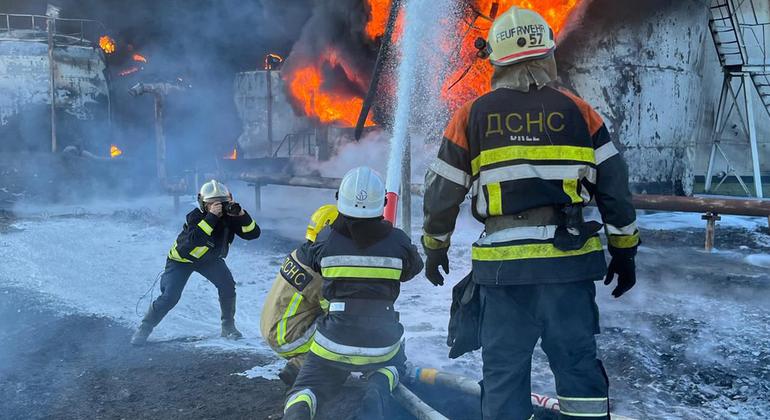The alert from the UN Human Rights Monitoring Mission in Ukraine follows significant destruction to power plants and the worsening energy crisis that has affected access to electricity, clean water and heating, while also pushing up prices for consumers.
The strikes on the national grid included one coordinated attack on 26 August which the Mission described in a new report as one of Russia’s largest since the onset of the full-scale invasion, involving “more than 100 missiles and 100 drones across numerous regions in Ukraine, primarily targeting energy and other infrastructure. Power cuts were implemented nationwide to stabilize the grid.”
There have been “nine waves of long-range and large-scale coordinated attacks” on Ukraine’s electric power system between 22 March and 31 August 2024, the report noted. These have either damaged or destroyed “numerous power generation, transmission, and distribution facilities” and caused harm to the civilian population and the country’s electricity supply, water distribution, sewage and sanitation systems, heating and hot water, public health, education and the economy.
The report further cites estimates that the latest attacks on energy infrastructure have “put over 10 per cent of the population – 3.7 million people – at risk of consuming contaminated drinking water. Risks increase for infants and young children, older persons, immune-compromised individuals and those with important comorbidities,” it noted.
High-voltage hits
Since March 2024, Russian attacks have hit facilities in 20 of the 24 regions under Ukrainian control, including the capital Kyiv, according to the Mission. These included 36 recorded strikes on power plants in nine regions and at least 101 confirmed attacks on electricity distribution and transmission facilities in 17 regions. “Many energy facilities were struck repeatedly, some until the point of total destruction,” it said, noting that it will “take years to fully repair and restore”.
Before the full-scale Russian invasion on February 24, 2022, Ukraine had 44.1 gigawatts of available electricity capacity, via its nuclear, thermal and hydroelectric plants, as well as renewable sources, the report noted, citing data from the National Bank of Ukraine. But by April 2023, Ukraine’s national grid had lost nearly half of its available production capacity from occupation and destruction. Additionally, 42 of its 95 high-voltage transformers were damaged, disrupting electricity distribution to homes.
Forced displacement fears
According to the UN refugee agency (UNHCR), more than 6.7 million Ukrainians have fled the country since the Russian invasion. Some 6.2 million are still in Europe and another 3.6 million remain internally displaced inside Ukraine. The UNHCR considers it “unlikely” that these numbers will decrease soon.
Border monitoring conducted by UNHCR and partners showed a slight increase in departures from Ukraine since April this year linked to a lack of access to electricity, water and heating. But “that rise then starkly increased” by June 2024 to one in four respondents as energy outages became more frequent. By July, nearly half of those contacted at the Ukrainian border said they were leaving because of difficulty accessing electricity, water and heating.
“Most of those departing for energy-related reasons are intending to stay abroad temporarily, but for unknown periods,” UNHCR said.
Education: Millions of classroom hours lost
Beyond the expected exodus of people from Ukraine, the attacks have seriously impacted education, too. In July 2024, the UN Children’s Fund (UNICEF) estimated that between 78 and 311 million hours of study have been lost each month from power outages.
After the initial waves of attacks in March 2024, the National Bank of Ukraine estimated that the national economy would shrink by 0.6 per cent. By June 2024, electricity prices rose by more than two-thirds. The country’s Government estimated that high electricity costs would add 1.2 per cent to consumer inflation and six per cent in additional costs for producers.
The UN Mission said that in view of the large number of regions affected by the coordinated attacks, “the high precision of the weapons involved, and the sheer scale of harm inflicted on civilians and interconnected civilian systems supplying the population with services essential to their health and survival…there are reasonable grounds to believe that multiple aspects of the military campaign to damage or destroy Ukraine’s civilian electricity and heat-producing and transmission infrastructure have violated foundational principles of international humanitarian law.”



